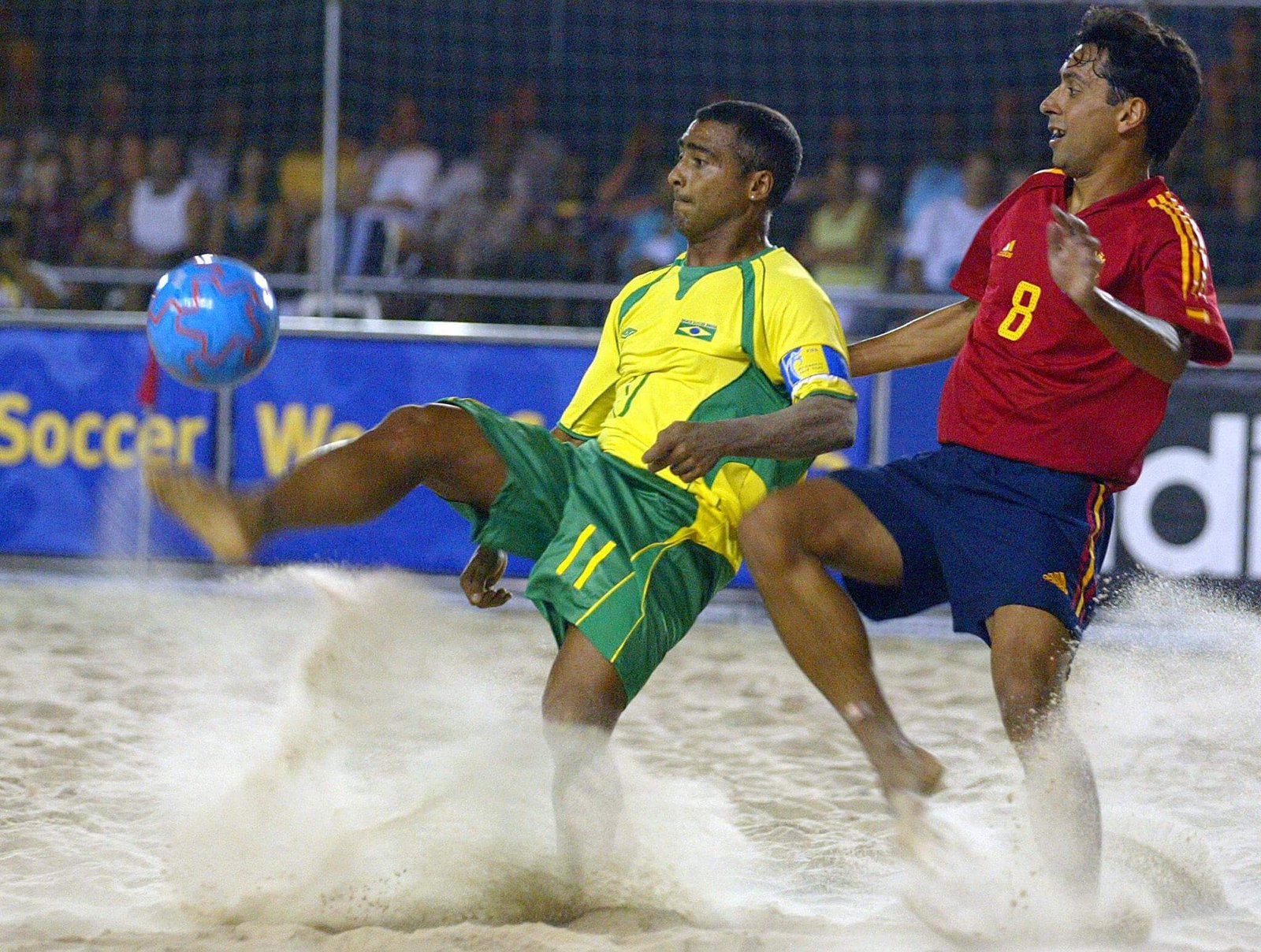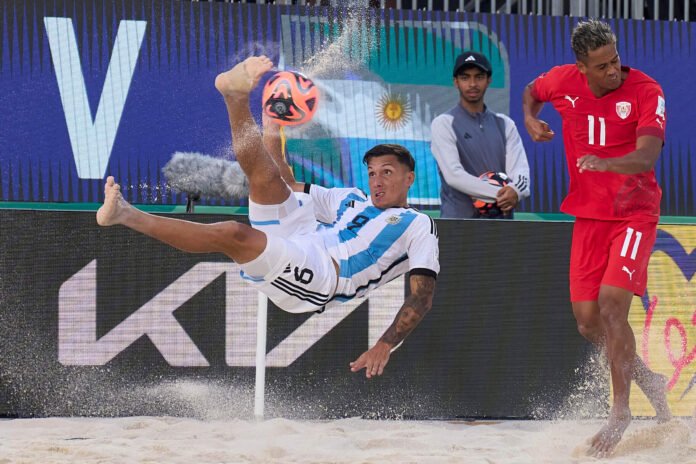As the players trudge off for a deserved rest, a graphic appears on the screen.
All the basic stats are there: possession, shots, shots on target. So far, so normal. One advanced metric, though, breaks cover.
“Overhead kicks,” it reads. OVERHEAD KICKS.
Yes, welcome to beach soccer, football’s sandy, fun-loving younger brother. And, indeed, welcome to the Beach Soccer World Cup, the sport’s biennial showpiece, which, at the time of writing, is precisely 12 minutes old.
The score in the opening match of the 2024 tournament, after the first of three periods of play, is United States 1-2 Italy. It has been pretty scrappy stuff, leavened only by the sight of Chris Toth, the U.S. goalkeeper, clobbering a shot against the Italian crossbar from his own half. Oh, and the discovery that one of Toth’s team-mates once had a bit-part in 2000s sitcom Malcolm in the Middle.
There have, so far, been zero overhead kicks.
Beach soccer has almost certainly been around — at least, in a crude form — since humans started playing with makeshift balls. The common consensus, though, is that the game really got started in Brazil.
There are tales of 11-a-side matches being played on Rio de Janeiro’s Copacabana beach as far back as the 1930s, and it wasn’t long before teams, competitions and organising bodies formed. In 2016, a law declaring beach football to be part of Rio’s cultural patrimony was passed by the city council, citing tournaments in the 1960s that attracted thousands of spectators to the waterfront.
What was previously an informal pastime began to solidify into something like a proper sport in 1992, when an American group called Beach Soccer Company — a precursor of the current governing body, Beach Soccer Worldwide — codified a set of rules. Three years later, with help from a Brazilian marketing firm, it was putting on the first Beach Soccer World Championship.
Italy’s 3-1 win over the U.S., played in the shadow of Dubai’s Burj Khalifa (Tullio Puglia/FIFA/Getty Images)
It took place — naturally enough — on the Copacabana, Barry Manilow’s favourite stretch of white sand. Brazil won that first edition and all but one of the subsequent nine (Portugal beat France in the 2001 final) before the tournament moved under the FIFA banner in 2005. This year’s Beach Soccer World Cup is the 12th since the rebrand.
Every edition of the World Championship took place in Brazil. So too did the first three World Cups. In the last 16 years, however, the tournament has been on a magical mystery tour, taking in France (2008), the UAE (2009 and this year), Italy (2011), Tahiti (2013), Portugal (2015), the Bahamas (2017), Paraguay (2019) and Russia (2021).
That opening-up has coincided with a loosening of Brazil’s grip on the sport: they have claimed just one of the last six titles. (Brazil are still the major force in the women’s game, which does not yet have a World Cup.) In the same period, there have been semi-final appearances for nations as diverse as Senegal, El Salvador and Tahiti (twice beaten finalists), while Russia have racked up three titles. The latter won the last edition on home sand but are not in Dubai this month due to an international ban.
Marco Giordani grabs the ball. The Italy forward has just won a free kick with a dive so heinous that it instantly dispelled any lingering notion that beach soccer might be a bastion of honesty and sportsmanship. “It’s a sport, not a show,” former Manchester United star Eric Cantona once said, and he wasn’t wrong.
Giordani makes a little hill in the sand. He smooths out a circle around its base, then places the ball on top of the mound. He will take the free kick himself. The rules dictate that he has to. As he walks back, the other seven outfield players — beach soccer is a five-a-side affair — peel away to the sides of the pitch. There are no walls in beach soccer. The beach does not impose barriers, man.
Eventually, after a run-up as long as Moby-Dick, Giordani shoots. The ball — lighter than a regular football and less pumped-up — whistles through the air and nestles in the top corner of the net.

Cody Valcarcel of the U.S. in action against Italy (Aitor Alcalde/FIFA/Getty Images)
This is perhaps the most alluring thing about beach soccer: how its players manage to transcend testing conditions to produce moments of beauty. Every spectacular goal or acrobatic save is a little victory carved out against common sense.
For one thing, the goals are small: 2.2 by 5.5 metres. Then there is the surface. This isn’t shoreline-just-after-the-tide sand; it’s the proper fluffy stuff, dune incarnate. Just jogging on it is tiring, let alone sprinting, jumping and the rest. Just ask Romario, who played for Brazil at the 2005 Beach Soccer World Cup having previously won the 1994 version played on grass in the U.S. “For me, 20 minutes on sand is more tiring than 90 on grass,” he said.
Unlimited substitutions help on that front, but not with the technical challenge. Because you cannot reliably move the ball along the ground, it spends a lot of time in the air. Players flick it up, juggle it and pass on the volley. Overhead kicks… well, the fact that there is a running count is instructive. Everything is done with bare feet; footwear is forbidden.
It is a testament to the fitness and technical ability of the players that matches tend to be high-scoring — and absorbing — despite the sky-high difficulty level. There were 9.4 goals per game in the 2021 World Cup and only once has that figure dipped below eight across 11 editions of the tournament.
For many, Cantona is the first person that comes to mind when they think of beach soccer. The Frenchman became the sport’s most prominent player after stepping away from ‘traditional’ football in 1997 and never passed up an opportunity to further the cause in the press.
“Everybody can play this game,” he said during a tour event in London in 2000. “You don’t have to buy a pair of boots for £60. You just need a ball and some sand.”
When Cantona led France to glory as player-coach in the first Beach Soccer World Cup, it cemented his place as an ambassador for the game. “That was one of my best moments — as a man, not only as a sportsman,” he later said.
Plenty of other prominent footballers have tried their hand at beach soccer over the years. The Brazil team who won the inaugural World Championship in 1995 included four former Selecao players, including genuine superstars in Zico and Junior.
Alessandro Altobelli, Claudio Gentile (both Italy), Luther Blissett (England) and the Van de Kerkhof twins, Rene and Willy (Netherlands), also appeared at that tournament, while later editions featured Gustavo Poyet (Uruguay), Michel, Julio Salinas (both Spain) and Romario, who scored six goals, including a hat-trick against Argentina, in 2005.

Romario in action during the 2005 Beach Soccer World Cup (Vanderlei Almeida/AFP via Getty Images)
Perhaps understandably, though, it’s the specialists who tend to dominate. The most obvious example is that of Joao Victor Saraiva, better known as Madjer, who scored an astonishing 88 World Cup goals for Portugal between 2005 and 2019. For context, the second top-scorer since the rebrand is Switzerland’s Dejan Stankovic, who has 47. (Switzerland, incidentally, are much better at beach football than a landlocked country has a right to be.)
This year, the names to look out for include Japan veteran Ozu Moreira, Be Martins of Portugal and the laughably springy Brazil forward Rodrigo, who was named the best player in the world this week and scored the most memorable goal of the 2017 tournament.
Giordani, the diving free-kick master, is also expected to leave his mark. With him occupying the U.S. defence and goalkeeper Leandro Casapieri in imperious form, Italy eventually earn a comfortable 3-1 win, taking a giant step towards next week’s quarter-finals. Later in the day, Tahiti will edge a seven-goal thriller against Argentina.
“Playing football on a beach with friends is the most exciting scene in life,” Cantona once said. “It’s a wonderful lifestyle.”
It is also, if Italy’s celebrations at full-time are anything to go by, serious business. Serious, sandy business.
(Top photo: Aitor Alcalde/FIFA/Getty Images)
Read the full article here


